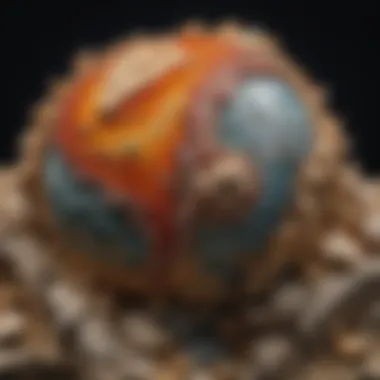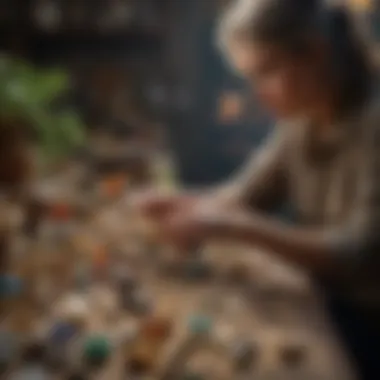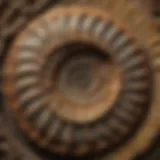Exploring Earth Jewelers: Masters of Geological Art


Intro
The world of geological treasures is vast and intricate. Earth jewelers play a pivotal role in this realm, as they merge artistry and science. Their skills manifest in selecting and presenting geological specimens, transforming them from simple finds to documents of earth’s history and beauty.
To appreciate their work, it is essential to understand the components that comprise this craft. This includes knowledge about rock and fossil identification, effective collecting techniques, preservation methods, and the geological insights that enrich our understanding of these natural wonders.
Recognizing the significance of earth jewelers helps collectors appreciate the nuances of geological specimens, elevating them beyond mere decorative items to meaningful artifacts of culture and history.
Rock and Fossil Identification
Identifying rocks and fossils is the foundation of collecting. This process requires a keen eye and an understanding of the varying characteristics that define these specimens.
Types of Rocks and Fossils
Rocks generally fall into three primary categories: igneous, sedimentary, and metamorphic. Each type has unique qualities based on its formation process:
- Igneous Rocks: Formed through the cooling and solidification of magma or lava. Examples include granite and basalt.
- Sedimentary Rocks: Created from the accumulation of sediments. Key examples are sandstone and limestone.
- Metamorphic Rocks: Result from the alteration of existing rocks due to heat and pressure. Notable examples are schist and marble.
Fossils, on the other hand, typically arise from the preservation of biological material, often capturing entire organisms or parts of them. Common fossil types include:
- Body Fossils: Actual remains, like bones or shells.
- Trace Fossils: Evidence of activity, such as footprints or burrows.
Characteristics to Look For
When assessing geological specimens, distinct characteristics are critical for proper identification:
- Color and Texture: Each rock exhibits a unique appearance.
- Hardness: This can be tested using common items.
- Strata: For sedimentary rocks, the layering of sediments may reveal their history.
Tools for Identification
Several tools assist in the identification of rocks and fossils:
- A hand lens allows for close examination of textures.
- A scratch test kit helps determine hardness.
- Field guides provide visual aids for species identification.
Collecting Tips and Techniques
Collecting geological specimens requires both knowledge and respect for nature. Here’s how to proceed effectively:
Best Practices for Collecting
- Always seek permission if you are on private land.
- Collect responsibly by adhering to local laws and regulations.
- Minimize environmental impact. Remove only what you plan to study or display.
Locating Prime Collecting Sites
Certain areas are known for rich geological deposits:
- National parks often have accessible trails.
- Riverbeds can reveal unique specimens
- Quarries generally offer a variety of rocks.
How to Safely Extract Specimens
Extraction should be done carefully:
- Use appropriate tools like chisels and hammers.
- Wear safety goggles to protect your eyes from debris.
- Lift with care to avoid damaging the specimen.
Preservation and Display
Preserving the integrity of geological finds is vital for lasting enjoyment.
Techniques for Preserving Rocks and Fossils
- Soaking specimens in water can help remove dirt.
- Using gentle cleansers can preserve detail without causing harm.
Proper Storage Methods
Protect your collection:
- Store in a climate-controlled environment.
- Use acid-free materials to avoid chemical reactions.
Creative Display Ideas


For showcasing collections:
- Consider shadow boxes for fossils.
- Use stands or pedestals for larger rocks.
Geological Insights
The study of geology enriches our understanding of the planet.
Geological Formations and Processes
Understanding the geological processes like erosion, sedimentation, and plate tectonics provides context for how rocks are formed and altered over time.
Historical Significance of Rocks and Fossils
Each specimen tells a story of the environment and changes over time. These specimens connect us to the distant past, offering a glimpse into how life evolved.
Notable Discoveries in the Field
Many remarkable finds have altered scientific understanding:
- The discovery of amber preserving ancient insects offers insights into prehistoric ecosystems.
- Fossils from the Burgess Shale have shed light on the Cambrian explosion of life.
By diving into the world of earth jewelers and geological specimens, collectors not only enrich their collections but also deepen their connection to the natural world.
Prologue to Earth Jewelers
The practice of earth jewelry sits at the intersection of geology and artistry, garnering attention from collectors and enthusiasts alike. Understanding this topic is crucial, as it unravels the meticulous work of artisans who transform geological specimens into valuable collectibles. Earth jewelers not only highlight the beauty inherent in rocks and fossils but also emphasize their significance in the broader cultural and scientific contexts.
The role of earth jewelers incorporates various aspects, including an appreciation for natural history, craftsmanship, and ethical considerations surrounding material sourcing. Their work can illuminate the intricate relationship between humans and the natural world, inviting introspection on our values regarding environmental sustainability and cultural heritage.
Definition and Context
An earth jeweler is a craftsman who specializes in the selection, shaping, and presentation of geological specimens. These individuals merge practical skills with a deep understanding of materials, transforming ordinary rocks and fossils into extraordinary objects of beauty and significance. In this context, geological artifacts become more than mere items; they represent millennia of natural history, evolution, and artistry.
In addition to personal expression, these jewelers play a crucial role in education about geological specimens. Their creations often prompt discussions about the origins of the materials and their relevance to geology, thus fostering greater awareness among collectors.
Historical Perspectives
The practice of crafting jewelry from natural materials dates back thousands of years. Ancient civilizations, including the Egyptians and Mesopotamians, often incorporated stones in adornments, believing in their mystical properties and intrinsic value. Fast forward to modern times, the earth jewelry movement as we know it has gained traction over the last century.
With the rise of rock and fossil collecting, artisans began to specialize in earth jewelry, acknowledging not just the aesthetic quality of these materials but their geological stories. This historical evolution reflects a growing appreciation for natural specimens and their value beyond the decorative; they are artifacts of Earth's history. In our contemporary world, earth jewelers continue to capture the imagination of collectors, merging tradition with innovation.
The Craft of Earth Jewelers
The craft of earth jewelers plays a crucial role in the appreciation and collection of geological treasures. These artisans not only select unique materials but also apply their skills to create pieces that hold both artistic and scientific value. Through their work, earth jewelers bridge the gap between geology and art, enabling collectors to appreciate the inherent beauty of natural formations.
Their expertise in handling various materials transforms raw geological specimens into objects of art. This transformation is important, as it allows these natural items to be treated with the significance they deserve. Collectors are not simply acquiring rocks or fossils; they are obtaining pieces of history, understanding their context in nature, and the craftsmanship involved in their presentation.
Techniques in Material Selection
Material selection is where the journey of an earth jeweler begins. This process is critical in determining the final outcome of the piece. Jewelers often consider various factors such as the source of the material, its geological history, and its aesthetic properties. They meticulously choose items that not only display uniqueness but also reflect the characteristics of the location from where they are sourced.
Earth jewelers may prioritize locally sourced materials to support sustainable practices and reduce environmental impact. By selecting materials from their immediate surroundings, they help preserve the natural ecosystem while offering collectors a direct link to the area’s geology.
Additionally, jewelers evaluate durability and texture. Some materials may appear visually appealing but can be fragile. For example, certain fossils or minerals like amber are beautiful yet require careful handling. The selection process ensures that the final piece is both stunning and structurally sound for longevity in collections.
Crafting Methods and Tools
Once the materials are selected, the next phase involves various crafting methods and tools. Earth jewelers often employ techniques that are both traditional and innovative. Tools such as saws, grinders, and polishers shape the raw materials into finished pieces. These instruments are essential for achieving refined edges and polished surfaces that enhance the natural beauty of the specimens.
Some jewelers utilize hand tools to maintain control over intricate details. For example, a diamond saw may be used for cutting larger specimens, while smaller tools are employed for delicate finishing touches. The use of technology also finds its place in modern practices, with some artisans exploring 3D printing and laser cutting to complement traditional methods.
Different crafting methods define the style and personality of each piece. It is important for collectors to appreciate the skill and time invested in these pieces. Such methods ensure that the final product not only showcases natural beauty but also embodies the talent of the artist.
Finishing Techniques for Presentation
Finishing techniques are integral to preparing the finalized pieces for presentation. This stage may include several processes like polishing, mounting, or framing specimens. Polishing is a particularly crucial step. It brings out the colors and patterns inherent in the material by smoothing out surface imperfections.
Mounting techniques can vary as well. Some earth jewelers opt for simple settings that emphasize the natural allure of the specimens, while others may create complex display cases that incorporate natural elements or historical context. Display choices can make a significant difference in how the pieces are received by collectors.
Proper presentation not only protects the materials but also enhances their visual appeal. The right finishing touches allow collectors to see geological treasures in a new light.


"The final presentation is where raw geology transforms into an artifact of beauty and history."
Significance of Earth Jewelers
The role of earth jewelers extends far beyond the mere crafting of geological specimens into decorative items. Their work reflects a bridge between the realms of art and science, profoundly influencing perspectives in both collecting practices and cultural appreciation of natural history. Earth jewelers possess an acute understanding of materials, enabling them to present rocks, minerals, and fossils in a manner that highlights their aesthetic and scientific value. This significance is manifested in various domains, notably cultural impacts, educational contributions, and ethical sourcing considerations.
Cultural Impacts
Earth jewelers play an important role in shaping how society perceives geological materials. They transform raw, unrefined collectables into unique pieces of art. By integrating these items into decorative formats, they not only beautify spaces but also tell stories of the Earth’s history. These creations can evoke appreciation for nature's complexity and beauty among a wide audience, moving potential collectors from a casual interest to a profound respect for geological treasures.
Moreover, these artisans often participate in exhibitions and cultural events that promote awareness about the significance of geology. Their initiative can foster a deeper understanding of local geology, leading to increased interest in conservation efforts and geological studies. Through their work, earth jewelers contribute to a cultural dialogue that elevates the status of geological specimens from simple objects to valued cultural artifacts.
Educational Contributions to Geology
Beyond their artistic contributions, earth jewelers serve as educators. Many share expertise through workshops, presentations, and community outreach. By teaching others how to appreciate and understand geological materials, they enhance public knowledge of geology.
Their presence in educational contexts not only emphasizes the scientific aspects of geology but also encourages hands-on learning. For instance, workshops can involve critical activities such as identifying minerals or understanding the formation processes of fossils. This experiential learning approach makes geology accessible and engaging, fostering a community that values scientific inquiry and appreciation of Earth's materials.
"Earth jewelers are not merely artisans; they are ambassadors of geological literacy, bridging the gap between passion and education.
Ethical Considerations in Sourcing
As the demand for unique and high-quality geological specimens increases, ethical sourcing has become a vital consideration. Earth jewelers must navigate the complexities of sustainability and conservation while sourcing their materials. Many are committed to sourcing responsibly, ensuring that the extraction processes do not harm the environment or exploit local communities.
Practices may involve working with local miners using artisanal methods that prioritize safety and sustainability. This commitment can also extend to advocating for the fair treatment of these communities, promoting transparency in transactions and sustainability in practices.
Additionally, educating collectors about the importance of ethical sourcing encourages a more conscientious collector community. Understanding where and how materials were sourced can influence purchasing decisions, moving collectors towards more responsible practices that support conservation and local economies.
In summary, the significance of earth jewelers encompasses cultural enrichment, educational engagement, and ethical sourcing. Each of these elements contributes to the broader understanding of geological treasures not merely as collectibles but as vital components of our natural and cultural heritage.
Sourcing Materials
The practice of sourcing materials is a fundamental aspect of the earth jewelers' craft. It not only influences the quality and uniqueness of the final piece but also impacts the market dynamics and sustainability of geological treasures. By carefully selecting materials, earth jewelers can enhance the aesthetic value and scientific significance of their pieces. They engage with both local and global sources while navigating the complexities of responsible sourcing.
Local vs. Global Sourcing
Local sourcing refers to acquiring geological specimens from nearby locations. This practice is beneficial as it often supports local economies and reduces the carbon footprint associated with transportation. Local materials can include stones and minerals that hold cultural significance in their respective regions. On the other hand, global sourcing allows jewelers access to a diverse array of materials that may not be found locally. This can include rare minerals or fossils from remote locations. However, global sourcing raises questions about the ethics of extraction and the potential for environmental harm. Earth jewelers must weigh the pros and cons of each sourcing method, ensuring that their choices align with both their artistic vision and ethical standards.
Sustainable Practices in Earth Jewelry
Sustainability is a pressing concern in today's environment, and earth jewelers must prioritize responsible sourcing. This can involve selecting materials from suppliers who adhere to ethical mining practices. Jewelers can also consider using recycled or upcycled materials, which not only minimize waste but also add an element of creativity to their work. For instance, incorporating reclaimed stones from older jewelry can transform them into contemporary pieces, reflecting a commitment to sustainability. Education about the sources of materials and seeking certifications from vendors can enhance transparency. These practices help protect natural habitats and ensure the longevity of geological resources, fostering a more sustainable approach to earth jewelry.
Challenges in Material Acquisition
Acquiring materials for earth jewelry comes with various challenges. One significant challenge is the accessibility of certain geological specimens. Some materials may be located in regions that are difficult to reach due to geographical barriers or regulatory restrictions. Additionally, the global market can be unpredictable, impacting pricing and availability. Fluctuations in demand can lead to scarcity in specific materials, which may drive jewelers to compromise on their sourcing standards. Furthermore, navigating legal frameworks regarding the trade of specific minerals or fossils can be complex. Jewelers must remain informed about regulations and best practices to ensure their sourcing remains ethical and lawful. This emphasizes the need for strong relationships with reliable suppliers and networks within the geological community.
"The commitment to responsible sourcing is not just a trend; it reflects a lasting change in the industry that prioritizes both beauty and ethical considerations."
Market Dynamics for Earth Jewelers
The dynamics of the market for earth jewelers are crucial for understanding how geological treasures are collected and valued. As the interest in natural history and collectible items has grown, earth jewelers have found themselves in a unique position. These artisans not only create but also influence market trends and consumer demand. Pricing, trends in the collector community, and the rise of online platforms are all intertwined in this intricate tapestry.
Trends in the Collector Community
Collector communities play a vital role in shaping market dynamics. As more individuals recognize the aesthetic and intrinsic value of geological specimens, the interest in earth jewelry has increased.
- Social Media Influence: Platforms such as Instagram and Reddit have allowed enthusiasts to share their collections and discoveries. This sharing fosters community engagement and promotes specific items that may gain popularity.
- Specialized Collecting: There is a distinctive movement toward specialized collections. For instance, collectors may focus solely on fossils or rare minerals. This focus often drives the demand for specific types of pieces, influencing both the prices and the availability of materials.
These trends collectively create a vibrant marketplace where earth jeweler's pieces become coveted treasures.
Pricing Structures and Valuation
Pricing is perhaps one of the most challenging aspects of the earth jewelry market. Several factors contribute to how items are valued:
- Rarity: Items that are rare or have unique features command higher prices. For example, a fossil from a significant geological period may sell for much more than a common mineral specimen.
- Condition: Like any collectible, the condition of the item significantly impacts its market value. Items that are well-preserved will typically fetch higher prices compared to those showing signs of damage.
- Market Demand: The fluctuation in demand also dictates pricing. When certain trends emerge, prices may rise rapidly. For example, a renewed interest in a specific geological era can lead to higher prices for related specimens.
Thus, understanding pricing structures is essential for collectors and sellers alike, as it directly influences buying decisions and market behavior.
Online Platforms for Selling
The rise of e-commerce has transformed how earth jewelers market and sell their creations. Online platforms offer significant advantages:


- Wider Audience Reach: Websites such as eBay, Etsy, and specialized geology marketplaces allow jewelers to reach a global audience. This access can lead to increased sales and the chance for prices to reflect international demand.
- Ease of Transaction: Selling online often simplifies the transaction process for both buyers and sellers. They can review sales histories, communicate directly, and utilize payment systems that make transactions smooth.
- Community Building: Many earth jewelers utilize platforms like Facebook and Reddit to not only sell but also engage with the community. This engagement fosters trust and leads to increased sales as collectors share their positive experiences.
"Online selling has opened new avenues for earth jewelers, enabling them to connect with a global community of collectors while promoting sustainability through direct sales."
Personalities in Earth Jewelry
The world of earth jewelry is rich with individuals who have significantly shaped the craft and its recognition. These personalities often bring unique perspectives, skills, and creativity to the field. Understanding these figures can offer valuable insights into the evolution and future of earth jewelry. They are not just artisans; they are storytellers and cultural custodians who connect the past with present.
Influential Earth Jewelers
Certain earth jewelers stand out for their exceptional contributions to the field. For example, artists like Kathy Jordan and Toni Sikes have pioneered innovative techniques, blending geology with artistry. Their work not only enhances the aesthetic appeal of geological specimens but also educates collectors on the geological significance of materials used.
By choosing specific techniques or materials, these jewelers reflect their unique philosophies.
- Kathy Jordan is known for her use of local stones, emphasizing sustainability in her creations.
- Toni Sikes blends historic geological knowledge with modern artistic expression, thus bridging the gap between science and art.
These personalities help foster community engagement, encouraging not just collecting but also a deeper appreciation of natural history.
Interviews and Testimonials
Interviews with influential earth jewelers reveal personal stories and motivations behind their craft. Many jewelers express that their connection to nature inspires their work. For instance, a conversation with David Koss highlighted his journey from geology to jewelry making. He indicated that each piece he creates is a narrative, reflecting the geological history of the materials.
Testimonials from collectors further illustrate the profound impact these artists have. Many collectors share how their interactions with jewelers have transformed their perspectives on geology. These first-hand experiences emphasize how the craft of earth jewelry transcends mere decoration; it is about connecting with nature’s history.
"Every stone has a story, and the jewelers are its narrators."
- Anonymous Collector
Community Contributions
The contributions of earth jewelers are not confined to their individual practices. Many actively engage in community-building initiatives. Workshops and exhibitions led by these artists promote knowledge-sharing. For instance, the Earth Jewelry Collective organizes events, inviting collectors and enthusiasts to learn about geological specimens and crafting techniques.
In addition, jewelers often donate a portion of their proceeds to environmental conservation efforts. This not only supports the sustainable sourcing of materials but also highlights their commitment to preserving the very resources they use. By supporting local education and conservation initiatives, these personalities exhibit the role earth jewelry plays in cultural and environmental dialogues.
In summary, the personalities involved in earth jewelry are pivotal to its development and appreciation. By focusing on influential jewelers, exploring personal insights through interviews, and examining community contributions, we can better understand the multifaceted nature of this craft.
The Intersection of Art and Science
The interplay between art and science in the realm of earth jewelry is essential for a rich understanding of this craft. Earth jewelers demonstrate a unique blend of artistic vision and scientific knowledge. The aesthetic appeal of geological specimens often hinges on a nuanced comprehension of the materials at hand. This section will unpack the aesthetic principles and scientific understanding that underpin the practice of earth jewelers, showing how their work transcends mere decoration.
Aesthetic Principles in Earth Jewelry
The aesthetic principles are a critical component of earth jewelry. Earth jewelers must appreciate the inherent beauty of geological specimens. This beauty is often shaped by color, texture, form, and size. Each specimen tells a story that earth jewelers must interpret when creating their pieces. For instance, the choice of a striking quartz crystal might amplify its clarity and sparkle through careful cutting and polishing. Additionally, the color palette of materials influences their visual appeal.
The positioning and setting of stones in jewelry further accentuate their aesthetic value. Earth jewelers often favor designs that bring out the natural beauty of the stone while ensuring functionality. Simple yet elegant settings can highlight a specimen's unique features. The integration of various materials also plays a significant role in achieving harmony in design. The combination of metals, such as silver or gold, with natural stones can enhance the overall aesthetic effect.
Scientific Understanding of Materials
The scientific understanding of materials in earth jewelry is crucial. Knowledge of geology and mineralogy deeply informs the selection and processing of materials. Earth jewelers need to understand the properties of different stones, including their hardness, cleavage, and composition. This knowledge allows them to select materials that not only look appealing but are also durable and suitable for various settings.
Interdisciplinary knowledge is often beneficial. For example, insights from materials science can help jewelers choose suitable adhesives and coatings that preserve the integrity of specimens. Additionally, light refraction and reflection principles can aid in selecting a stone that enhances the overall aesthetic when appropriately set in jewelry.
"Earth jewelry is where natural beauty meets human creativity and scientific insight."
Future of Earth Jewelry
As the landscape of collecting evolves, the future of earth jewelry presents exciting possibilities. This section examines emerging trends, innovations, and the potential for growth within the market. The relevance of these topics is stark, especially for enthusiasts who have a vested interest in geological specimens. Earth jewelry is not just a niche; it is positioned at the intersection of art, science, and personal connection to nature. Understanding these dynamics is crucial for collectors and artisans alike.
Emerging Trends and Innovations
Several trends are shaping the future of earth jewelry. One notable trend is the increased use of technology in both the crafting and sourcing of materials. Advanced tools like 3D printing are making it possible to create intricate designs that were previously not feasible. This innovation not only enhances creativity but also increases accessibility for artisans.
Additionally, sustainable practices are becoming more mainstream. Many collectors today express a preference for ethically sourced materials. This shift reflects a broader societal demand for eco-conscious products. Earth jewelers who adopt sustainable methods often find a loyal customer base that values transparency and accountability in sourcing. Elements such as local sourcing and eco-friendly materials are now significant selling points.
Another trend is the integration of educational elements into the design and narrative of earth jewelry. Artisans are increasingly providing context about the geological significance of the materials used. Such information not only enhances the value of the pieces but also informs and engages collectors, fostering a deeper appreciation for the craft.
Potential for Growth in the Market
The market potential for earth jewelry is expansive. As awareness of geological treasures grows among a broad audience, there is increasing interest from both seasoned collectors and newcomers. The rise of online platforms facilitates this growth. Collectors can find unique pieces from around the world without geographical limits, widening the reach of earth jewelers.
Moreover, participation in trade shows and community events has increased. Earth jewelers are now connecting directly with customers, leading to evolving market dynamics. This personal engagement allows them to showcase their work and build community around the shared passion for geology.
With the growing interest in natural history and the arts, the future looks bright. It is essential for artisans to continue adapting to new market trends, respond to collector interests, and prioritize sustainability.
"The more we understand about the materials and their significance, the more we appreciate their beauty and rarity."
In summary, the future of earth jewelry holds a wealth of opportunities. By aligning with emerging trends and focusing on growth strategies, earth jewelers can solidify their place in the evolving landscape of geological collectibles.







